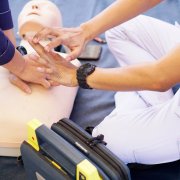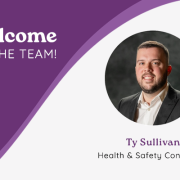
Choking occurs when a person’s airway is blocked, preventing them from breathing. This is an emergency that can quickly worsen if the person is unable to clear their airway on their own and does not receive help.
What does choking look like?
If the person has a severe airway block, they cannot breathe, cough, speak, or make sound. The person may demonstrate the universal choking sign by clutching their hands around their neck, crossing at the wrists. They may appear panicked, shocked, or may appear unsure what to do.
While a person who is choking often will attempt to alert others around them, it is important to be aware that this does not happen in all cases. In some cases, the person may be embarrassed and/or panic may overpower the logical thought process of seeking help. In some of these cases, the individual may excuse themselves to use the restroom, leave a restaurant, or remove themselves from the setting in another manner, making it more difficult for others to realize something is wrong.
What should I do if I think a person is choking, or might be about to start
choking?
If the person is still able to cough or speak, stay with them. Encourage them to continue to cough until the object comes out. If the person is not able to cough, speak, or breathe, ask the person if they are choking and if you can help. If the person is choking, the person may nod their head and/or demonstrate the universal sign for choking, described earlier in this tip. For a person who is choking and is still responsive, The American Heart Association recommends abdominal thrusts (see exceptions for a person who is pregnant or in a wheelchair).
How to perform abdominal thrusts for an adult who is choking:
1. Stand behind the person. For someone who is much shorter than you, you may need to kneel behind them.
2. Make a fist with one hand. Place your fist just above the person’s navel, thumb side inward, and your other hand over the fist.
3. Make quick upward thrusts into the abdomen until the object comes out, or until the person becomes responsive. For pregnant person is who is choking and responsive, you will do chest thrusts instead of abdominal thrusts. Follow the same steps as above, but instead placing your fist slightly above the navel, place your fist in the center of their chest, reaching around them from underneath their armpits. Instead of upper thrusts into the abdomen, you will perform chest thrust that are straight back into the person’s chest (not upward).
You can also do this for someone who is in a wheelchair if the wheelchair prevents you from accessing the person’s abdomen. If the person becomes unresponsive, you should shout for someone to call 911, get an AED, and do the following.
1. Slowly lower the person onto their back.
2. Provide CPR, starting with compressions.
3. After 30 compressions, open the mouth and look for the object. If you can see the object, remove it. Do not attempt to remove an object you cannot see.
4. Give 2 breaths.
5. Continue to repeat 30 compressions, checking for the object and removing it if visible, and giving 2 breaths until the person moves, speaks, blinks, or reacts in another way.
What to do if you are alone and choking?
Unfortunately, we cannot perform abdominal thrusts on ourselves effectively. If nobody is around to help, you will need to find an object that can be used to mimic the up-and-inward motion of an abdominal thrust as best as you can to dislodge the blockage. The object should be sturdy and large enough to thrust yourself onto. A chair often works well. Thrust your body onto the object, mimicking an abdominal thrust, until the object comes out or until you can speak, cough, and/or breathe.
Relief of choking is a skill covered in CPR/AED & First Aid Training. For information on training offered by The Lawson Group, please contact [email protected].
{{cta(‘c96d21ef-2126-4520-bd09-059d2d28e81a’,’justifycenter’)}}





